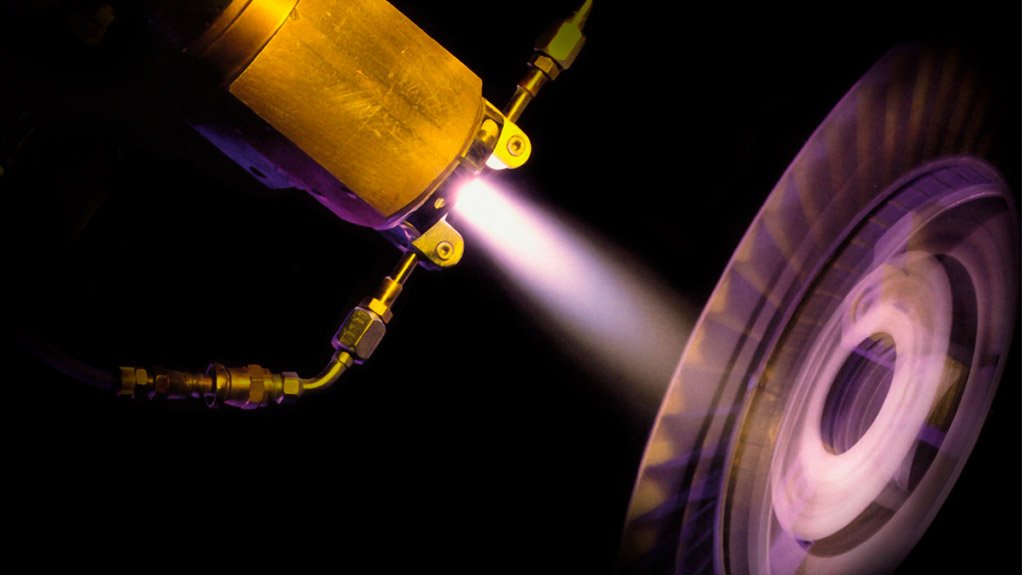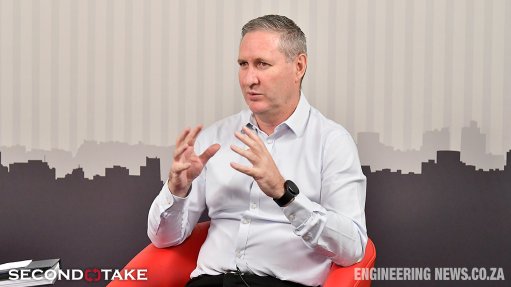SOFC and Thermal Spray, General.
This article has been supplied as a media statement and is not written by Creamer Media. It may be available only for a limited time on this website.
R. Hinckley
Solid Oxide Fuel Cells (SOFC), and hybrid electrical generation systems based upon this technology offer the potential for highly efficient utilization of abundant natural gas resources. Projected efficiency for SOFC-based systems for electrical power generation could reach as high as 65%.
Solid oxide fuel cells generate electricity by the electrochemical oxidation of the incoming fuel across a gas-impermeable but ionically conductive electrolyte.
As the name implies, SOFC’s utilize solid oxide ceramic materials as their functional layers (Anode, Electrolyte, and Cathode). As the ionic conductivity of the electrolyte is critical to proper function of the fuel cell, and the conductivity of common electrolyte materials is proportional to temperature, SOFC systems operate at far higher temperatures compared to PEM or other fuel cell technologies.
Hybrid SOFC systems utilize multiple approaches, with secondary electrochemical oxidation via a secondary fuel cell stack, or combustion in an internal combustion engine or gas turbine of the anode (fuel electrode) tail gas to extract remaining chemical and thermal energy. These system designs provide the optimal efficiency in cases where waste heat cannot be readily utilize. As most solid oxide fuel cell systems operate at temperatures in excess of 750C, and once in operation sustain this temperature, recapture of waste heat in a Combined Heat and Power (CHP) configuration for heating of water, or structures allow even higher equivalent efficiency in the utilization of natural gas.
Combustion of the anode tail gas can be utilized to further improve the net heat yield from the fuel.
In addition to the increased efficiency compared to other methods of electrical generation from natural gas including industrial gas turbines, internal combustion engines, or steam turbines, SOFC technology offers a reduction in emissions of CO, CO2, and perhaps most critically, oxides of Nitrogen (NOx). The low emissions of SOFC-based power generation systems allows for siting in locations where no other type of power generation resource could be permissible.
Thermal spray technologies such as APS (Atmospheric Plasma Spraying) and SPS (Suspension Plasma Spraying) offer the promise of dramatically reducing the cost, and increasing the yield of SOFC manufacturing when compared to bulk ceramic sintering processes. The ability to apply extremely thin layers, with varying microstructure and mechanical properties is ideally suited to the fabrication of the functional layers and protective layers of solid oxide fuel cells.
A porous, composite anode layer applied by APS or SPS processes is ideal in that it can provide the required gas permeability, while maximizing area for triple phase boundary (Electrolyte, Fuel, and Anode material present). As this layer can be applied to a metallic supporting interconnect, at lower thickness, (less resistive power loss in a stack), performance of the cell stack can be improved by this approach.
Note that the materials used for the Anode will vary with required operating conditions and design.
As previously stated, the Electrolyte layer must be entirely impermeable to the fuel gas (Cells operate at 700+C, air on the other side of the electrolyte), or combustion of the fuel, and loss of operating efficiency can occur. Advances in thermal spray processing make the application of dense, gas-impermeable electrolyte layers by thermal spraying possible.
The typical material used for the electrolyte is Yttria Stabilized Zirconia (YSZ), the same material commonly used in the Thermal Barrier Coatings (TBC’s) used in aircraft engine and stationary gas turbines. The extensive fundamental research in the thermal spraying of YSZ for TBC applications paves the way for thermally sprayed YSZ electrolytes for SOFC’s
Additional layers, such as the Cathode (Air Electrode) may also be fabricated by thermal spraying in much the same manner as the Anode (as the Cathode must also be gas permeable. Depending upon the material set chosen for the cell, additional barrier layers to prevent degradation mechanisms such as chromium poisoning of the Cathode may also be applied by thermal spray methods.
In addition to playing a critical role in current electricity generation in Industrial Gas Turbines, thermal spray technologies are well positioned to contribute to the next generation of clean, efficient energy generation, in an expanding role in SOFC Fabrication.
Comments
Press Office
Announcements
What's On
Subscribe to improve your user experience...
Option 1 (equivalent of R125 a month):
Receive a weekly copy of Creamer Media's Engineering News & Mining Weekly magazine
(print copy for those in South Africa and e-magazine for those outside of South Africa)
Receive daily email newsletters
Access to full search results
Access archive of magazine back copies
Access to Projects in Progress
Access to ONE Research Report of your choice in PDF format
Option 2 (equivalent of R375 a month):
All benefits from Option 1
PLUS
Access to Creamer Media's Research Channel Africa for ALL Research Reports, in PDF format, on various industrial and mining sectors
including Electricity; Water; Energy Transition; Hydrogen; Roads, Rail and Ports; Coal; Gold; Platinum; Battery Metals; etc.
Already a subscriber?
Forgotten your password?
Receive weekly copy of Creamer Media's Engineering News & Mining Weekly magazine (print copy for those in South Africa and e-magazine for those outside of South Africa)
➕
Recieve daily email newsletters
➕
Access to full search results
➕
Access archive of magazine back copies
➕
Access to Projects in Progress
➕
Access to ONE Research Report of your choice in PDF format
RESEARCH CHANNEL AFRICA
R4500 (equivalent of R375 a month)
SUBSCRIBEAll benefits from Option 1
➕
Access to Creamer Media's Research Channel Africa for ALL Research Reports on various industrial and mining sectors, in PDF format, including on:
Electricity
➕
Water
➕
Energy Transition
➕
Hydrogen
➕
Roads, Rail and Ports
➕
Coal
➕
Gold
➕
Platinum
➕
Battery Metals
➕
etc.
Receive all benefits from Option 1 or Option 2 delivered to numerous people at your company
➕
Multiple User names and Passwords for simultaneous log-ins
➕
Intranet integration access to all in your organisation




















